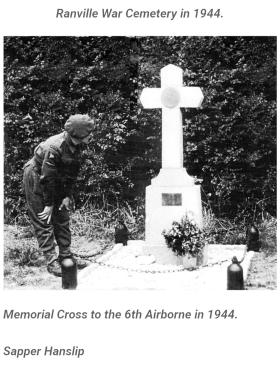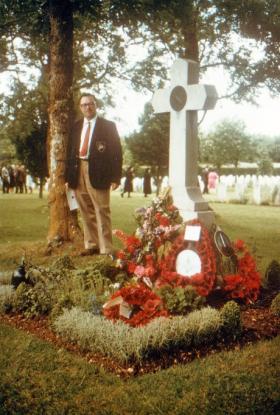The "Field Park" was the workshop, equipment, plant and stores unit of the Divisional Engineers and important though it was it seldom gained a front line role. However, in order to maintain morale the CRE had told 286 Field Park Company RE (Airborne) that every effort would be made to include at least elements of the unit in the initial assault.
Because of the weight limitations imposed by parachutes and gliders, carriage of the standard types of bulldozer was not possible and the Plant element was equipped with light wheeled agricultural tractors. The Company itself made bulldozing blades for these, ingeniously operated with oleo legs from the undercarriage of bomber aircraft but as a machine it was not a great success. However a month or two before the invasion took place the CRE heard that a small American bulldozer, called a Clark Crawler Tractor, had been used in a glider landing by Wingate's Chindits behind the Japanese lines in Burma. The CRE visited the HQ United States Aviation Engineers in England and asked if he could have three of these machines. "Sure", said the Commanding General, "Just get your CG to drop me a line and they're yours." So the Plant Troop got three of these small bulldozers which would load into a Horsa glider without dismantling.
As they would be valuable in clearing the glider landing zones for the second and main landing on the evening of D Day a detachment of fifteen Sappers under Lieutenant "Gunner" Reid RE of 286 Field Park Company RE (Airborne) was to land in four gliders with the first glider wave at 0320hrs. Three of these gliders were each to carry a Clark bulldozer, one American tipper trailer, petrol and tools. The fourth glider was to carry a jeep and air compressor.
Two of the three gliders carrying bulldozers and the fourth with the jeep and air compressor landed as planned at 0325hrs. It is believed that the remaining glider broke its tow rope over the Channel and landed in the sea. Sadly the bulldozer operator involved was a Sergeant Rousseau RE, a French speaking Channel Islander, whose linguistic ability would have been most useful. Unloading the bulldozers posed some problems. One broke the loading ramp on the glider but survived the drop to the ground. The second was also difficult to unload as the glider had shed its nosewheel. Both machines were working on their strips within one and a half hours of landing, about 0445hrs. In eight hours and well in time for the next glider force landing at 2100hrs, they had cleared, unassisted, glider debris from the first landing as well as filling in holes on the two easterly strips where the poles had not in fact been placed in the ground. During this time the LZ had become subject to some sniping, mortar and shell fire but despite this the operators persevered and completed their task.
The other requirement at an early stage was for an Engineer stores collection and distribution unit and the balance of the detachment mentioned above was organised to do this. Only part of the bomb bays in the parachute aircraft was required to carry equipment containers for the use of the paratroops it was to drop. The remainder of the bomb bays was therefore filled with containers of stores likely to be needed, principally anti-tank mines. These latter containers were released shortly after the equipment containers and the system called the Jettison Drop. This Jettison Drop was inevitably very scattered and though only about fifty per cent of it was retrieved, it proved to be a valuable bonus.
There was a further development of the Jettison Drop principle. HQRE heard that all the RAF tug aircraft towing gliders were to drop their nylon tow ropes into the Channel on their way back to their base. These tow ropes might be most useful to the Engineers on the ground whose resources were naturally very limited. So arrangements were made for each stream of tug aircraft to drop their tow ropes over specified map squares in Normandy itself, where they could be collected later.
Tragically Lieutenant Reid RE was killed soon after landing, the first Divisional Sapper Officer to fall in action.
It would be an omission in this account of the work of 286 Field Park Company RE (Airborne) not to mention the Memorial Cross. Sadly the temporary divisional burial ground at Ranville began to fill and later in June 1944, when there was a lull in the battle, the CRE approached the Divisional Commander and Senior Chaplain, George Hales with a design for a simple temporary memorial cross sketched on the back of a message form. Both readily agreed. The cross was actually made by Sapper Hanslip RE of cement cast in moulds and speckled with coal dust to simulate marble. A Pegasus and "6 June 1944" were attached, made from copper compressed air bottles salvaged from derelict gliders, beaten flat and stippled with the Pegasus design and lettering. The cross was erected on 24 June 1944 and consecrated by the Senior Chaplain. The burial ground became a permanent War Graves site and the cross was still standing thirty years after - and still is, it is believed - a fine tribute to Sapper Hanslip's workmanship. In the days when the annual Airborne Pilgrimage took place, the service in the cemetery was always held round this memorial cross rather than the much larger formal one erected by the War Graves Commission.
Reproduced courtesy of the Royal Engineers' Journal
Read More





Latest Comments
There are currently no comments for this content.
Add Comment
In order to add comments you must be registered with ParaData.
If you are currently a ParaData member please login.
If you are not currently a ParaData member but wish to get involved please register.